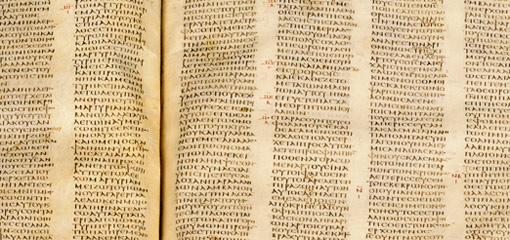
Anderson (1861) Including The Shepherd of Hermas and The Epistle of Barnabas. Discovered by Constantine Tischendorf at Mt. Translated from the Sinaitic Manuscript. It contains all of the Christian Greek Scriptures and portions of the Greek translation of the Hebrew Scriptures known as the Septuagint.Scholars consider Codex Sinaiticus to be one of the authoritative sources for the Greek Bible text.Codex Vaticanus, Codex Alexandrinus and Codex Sinaiticus Septuagint Manuscripts online July 9, 6 Comments The Septuagint (from the Latin septuaginta, seventy) is a translation of the Hebrew Bible and some related texts into Koine Greek.Perched in the middle of a Victorian dining room, and surrounded by antique Asian vases, the world's third oldest Bible is now on display in Washington, D.C.The New Testament: Codex Sinaiticus. The Codex Sinaiticus is a vellum manuscript written in Greek and dating from the fourth century C.E.
The symbol for the Codex Sinaiticus is the Hebrew letter. Codex Sinaiticus has a dedicated website (codexsinaiticus.org) and is also. The codex plays a pivotal role in scholars' understanding of the New Testament's history and speaks to how early Christians saw the Gospels.Images of many, but not all, Septuagint manuscripts are available online. Is a production of The Jackson Snyder Bible.The Codex Washingtonianus, located at the Smithsonian's Freer Gallery of Art, is so closely guarded that it rarely makes public appearances—until now.
The public can view the rare Bible and manuscript at the gallery until February 16, 2014, without charge. The two remaining manuscripts are too delicate or damaged to be put on display. Curators recently put the priceless document on display in the Freer Gallery's Victorian Peacock Room, along with a second of four ancient manuscripts purchased by Detroit businessman Charles Lang Freer, the museum's founder. For example, John 1:18 reads: No man has seen God at any time the only-begotten god who is in the. It also helps modern Bible scholarship by pinpointing subtle errors that crept into later copies.
Codex Sinaiticus Online Translation Skin Are Still
(See also " Lost Faces of the Bible.")"Ninety percent of our surviving manuscripts are from the tenth century or later," said Michael Holmes, a biblical scholar at Bethel University in St. The pages are sensitive to light and humidity, which is why the codex never leaves the museum and isn't exhibited very often.Although it looks a little worse for the wear—the edges were burned in a long-ago fire and pores from the animal skin are still visible—it's an important part of biblical scholarship. It is written in Greek on parchment—processed leather scraped thin to form pages. In the translation from Hebrew into Greek known as the Septuagint.The codex was transcribed in Egypt during the era of the Eastern Roman Empire, likely in the late fourth or early fifth century.
Conservative Christians were unhappy about that, he added.So the publication of the Codex Washingtonianus, with its additional passage attributed to Jesus, caused more consternation because it was another challenge to the Bible people knew, Evans said.It's not so much a problem now, he said. "Somewhere between 330 and 340." The Codex Washingtonianus is in rarefied company, he added.In addition to its rarity, the Washingtonianus is best known for an extra passage near the end of the Gospel of Mark that is attributed to Jesus and that doesn't appear in any other known biblical manuscript.The part that caught the attention of the public in the early 1900s reads in translation: "And Christ replied to them, 'The term of years of Satan's power has been fulfilled, but other terrible things draw near.'"That passage seemed to address the question of whether God or Satan was in charge, said Bethel University's Holmes.At the time, news of the passage came amid rumblings that the King James Version wasn't sufficiently representative of the earliest iteration of the Bible, said Evans. They are the Codex Vaticanus, which is held at the Vatican, and the Codex Sinaiticus, most of which is held at the British Library in London."They're both fourth century," said Evans.

Freer bought it in 1904 and had it shipped to America.Freer believed that art should be enjoyed for its own sake, said Glazer, so he would display pieces from different time periods and genres together.The way the Peacock Room is currently displayed in the Smithsonian gallery mirrors how Freer displayed it in his home in 1908, said Glazer, complete with Asian ceramics.Glazer hoped that by seeing the Washingtonianus in the former dining room, people would get a better sense of how Freer viewed his own collection.He was trying to "create this story of beauty that reached back in time and forward into his own time," Glazer said.


 0 kommentar(er)
0 kommentar(er)
